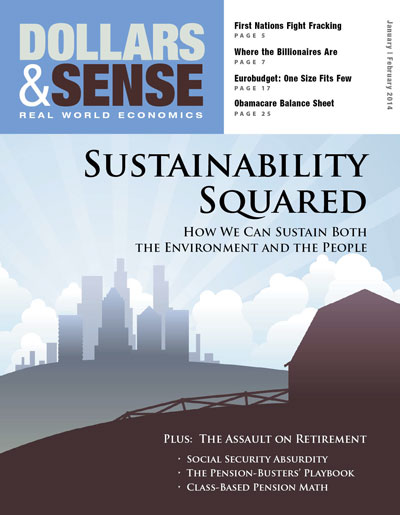Health Insurance for 20 Million is at Risk
If Congress fails to renew the ACA enhanced benefits, millions will be unable to access the health care they need.

Our January/February issue is (finally) out. We had already been posting articles (it's the layout that takes so long); but today I was able to post the cover article, Sustainability Squared, by Polly Cleveland, and the table of contents. Here is the editorial note from p. 2:
With this issue, Dollars & Sense begins its 40th-anniversary year.
The link between 2014 and 1974, however, is no mere arbitrary anniversary—the intervening years have brought us from one structural crisis of U.S. and world capitalism to another.
The 1970s were a time of oil price shocks, “stagflation” (the surprising advent of simultaneous high unemployment and high inflation), and a still-uncertain face-off between employers and a wounded (but not decisively defeated) labor movement. Reaganomics was still years away, as was Thatcherism in the UK. Likewise the Latin American debt crisis, structural adjustment, and the neoliberal reshaping of the region.
There was, however, cause for hope as well as trepidation. The 1960s and early 1970s had seen the emergence of new revolutionary movements across the world (and, alas, untimely defeats of some). The energy of the antiwar, black liberation, women’s liberation, and fledgling environmental movements reverberated through U.S. politics. Grassroots rebellions shook the AFL-CIO’s narrow business unionism and conservative official politics. Contending forces pointed to divergent paths out of the economic crisis—including both “free market” and government-interventionist approaches. Radical economists wondered whether proposals for new forms of state intervention in capitalist economies could be headed off in favor of more radical solutions.
Today, we’re living through another interregnum, this one arising from a structural crisis of neoliberal capitalism. The prostration of the labor movement, gaping economic inequality, the increasing “financialization” of capitalist economies—not surprisingly, to critical economists—have led to a rickety economic-growth model. Booms are fueled by debt, wild financial risk-taking, and speculative bubbles. Crashes lead to protracted periods of stagnation and high unemployment. Where policymakers have “doubled down” on neoliberal policies, it has become increasingly clear that this is a recipe for prolonging the crisis. (See Philip Arestis and Malcolm Sawyer, “The Eurozone Balanced-Budget Disaster,” p. 17.) No clear way out of the impasse has yet emerged. In the United States, capital and, especially, finance, are still riding high. There is little inkling of significant radical opposition, not even of the magnitude of the 1970s, to say nothing of the 1930s. But the battle is not yet done.
So, to begin this 40th-anniversary year, Dollars & Sense continues to intervene in the way we have all along—we keep making sense.
We show the class offensives unleashed from on high for what they are. In this issue, Katherine Schiacchitano and Rob Baiman expose the thinly veiled theft of public-sector pensions. In “Up Against the Wall Street Journal,” Marty Wolfson shows the deceptions behind debt scare-mongering, and how they’re used to attack Social Security.
We look critically at existing reforms and reform proposals, recognizing both their accomplishments and limitations. In “Economy in Numbers,” Gerald Friedman looks at our patchwork health-care reform, and points out the differences a single-payer system would make. Steven Pressman’s “In Review” considers the case for public banks and finds them, if not the end-all solution, then at least part of the solution to our current problems.
Finally, we cover the resistance movements and visions of more fundamental change that stoke hope for the future. In “Active Culture,” Seth Grande describes how an indigenous-led coalition has, so far, faced down both a multinational oil-and-gas corporation and a Canadian government hell-bent on becoming a global energy superpower. Polly Cleveland’s cover story, meanwhile, looks at the ways that existing technology can be deployed to achieve both environmental sustainability and rising employment and wages.
One way the current interregnum differs from the one into which Dollars & Sense was born is that the stakes, if anything, have grown higher. It is abundantly clear now, given the menace of climate change, that what hangs in the balance is the very habitability of the earth. That makes it all the more urgent to link today’s frontline social struggles with grand visions for the kind of future—egalitarian, cooperative, and sustainable—that we need.
Enjoy!
--Chris Sturr